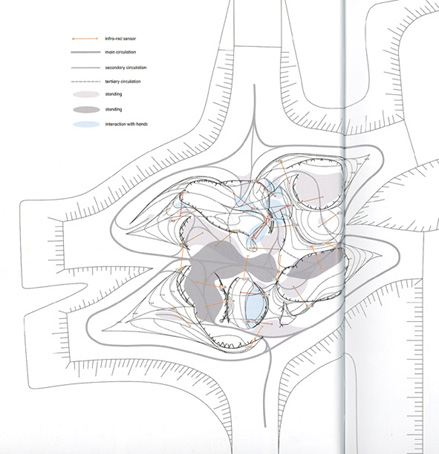Design And Performance Lab
|
Conceptual Notes
metallic grid landscape in Soncube For the projected new work, a new concept seems to be necessary. I suggest treating our process as a construction of an audio-visual installation. The role of performance is different for a dancework-digital installation such as "Suna No Onna", and in the case of "the NIght of the Living Return", I suggest to treat the Sonic Lab architecture specifically as the large-space environment of smaller cubic spaces that we can develop further. In the case of architecture for audience exploration (of the original idea of "navigable music"), you will clearly invite the visitor to go in, explore, journey through the "architecture". The sound that is experienced, I suggest, is related to both the movement or physical experience of the three-dimensional space (which includes virtual/projective space) and the imagined landscapes or stories or processing happening in the visitor. There is something to learn about the approach to the embodied experience (and the concept for such experience design) in REAL-TIME INTERACTIVE HUMAN-MACHINIC ARCHITECTURES or feedback systems, in an interactive system designed to function both ways - (a) incite, affect or indirectly motivate audience experiences and internal, intensive processes, (b) invite audience behaviors to feed back to the system which generates responses to the behavior. Such intertwined behaviors we can achieve by working with interactive (networked) interfaces and one, two, three, four spaces or fields within the larger instrallation, while we will also need to have programming that involves generative algorithms. Such an architecture is not the same as thinking of an actor or performer performing for the audience, or a linear screen medium (projected film) being used to evoke landscapes. I receommend to look at some current thinking on mapping, and beyond that, on emergence, real-time enaction and indirect interfaces (with autonomous agent-based, intelligent environments in which sonic and graphic behaviors emerge). For your critical reflection, i add some passages (>Embodiment: The Machinic and the Human<) which are part of a larger discussion that I saw beginning last year when we debated mapping against artificial intelligence and agent-based design.
Embodiment: The Machinic and the Human Mark Hansen
With the stabilization of the interdisciplinary domain of new media art into an identifiable, if wildly heterogeneous, set of practices over the last quarter century, the fundamental correlations linking media development with human embodiment have become increasingly evident and increasingly interesting. Now that we have lived for (at least) a decade with the digital, which is to say, an environment ubiquitously supported by processes of digitization, we are in a position to reject the initial prognostications concerning the digital: namely, the various ways in which it would supposedly free us from the alleged constraints of materiality - from the particularities of our bodies and culturally imposed identities and also from the fixity of cultural memory storage mechanisms and information dissemination systems. We can now say that there is an inescapable correlation of human embodiment and technical mediation along with the larger process of human technogenesis that it exemplifies: far from divorcing information from materiality and absolving it of any necessary coupling with embodiment, the flexibility characteristic of the digital - the capacity for variable or multi-form platform output - has made these twin correlations more imperative than ever. For if digital information in its raw state - as digital data (strings of 0s and 1s) inside the computer - has no direct sensory interface with embodied perceivers and cognizers, then the role of the human-computer interface becomes crucial. It is important to underscore the dual structure of the interface: the interface encompasses computer-mediated rendering of data coupled with motorically triggered human response. In contradistinction to the apparatuses of cinema, video and photography, where the framing of information is pre-inscribed in the technology itself, withy digital environments and interfaces, the spectator-participant must contribute to the process of framing by actively selecting data in conjunction with the computer. With the digital, to put it in even blunter terms, the human and the machinic must co-function to produce images out of information. (1) Cybernetic Legacies In their recent book, L'Art numérique, Edmond Couchot and Norbert Hillaire make the effort to think new media within the larger history of technology. "Informatics and its formalized models," they argue, "truly mark a new state of technics. A hybrid of hardware and of software, informatics is a technology in the literal sense of these terms, a fusion of techne and logos."(2) Understood in this way - as a conjunction of hands-on know-how and discursive knowledge - "informatics" can easily be situated within the trajectory of postwar cybernetics, a movement which, after all, was inspired by the dream of modelling the machine on the human being. The salient question which in both cases is how to think the human and the technical in their commonality. Yet informatics as here defined marks something of a reversal in the directionality of the initial cybernetic project. Arguing that the activity of simulation defines the digital image in all its forms, Couchot and Hillaire claim that the task of modelling the machine on the human now gives way to that of (re)introducing the human -which is to say human embodiment - back into the simulational circuit. One important consequence of this reversal of directionality is that the new state of technics has as its necessary correlate a new aesthetics, likewise understoon in its literal sense - as aesthesis, the sensing-perceiving of the world. Insofar as it foregrounds both the materiality of digital technology and the materiality of human embodiment, this new aesthetics not only counters the dominant legacy of the cybernetics project - the divorce of informational pattern from material embodiment - but also asserts the inseparability of the experiential (aisthesis) from the technical. Where a first-generation cybernetician like Norbert Wiener could only ward off the threat of technical contamination by dogmatically proclaiming the human to be inviolate,(3) Wiener's contemporary legatees - a diverse group encompassing researchers in fields ranging from artificial life to robotics, cognitive psychology to neurobiology -celebrate and draw inspiration from the mutual interpenetration of the human and the technical. For these researchers, there is nothing to fear in the convergence of the human and the machinic: the human has always been technical, it has from the beginning evolved through means other than life, and we not only need not fear technical contamination, but we can and must invest it as a crucial dimension of our ongoing evolution, of what must henceforth be called our "human technogenesis." In light of this conclusion, the role of art undergoes a fundamental mutation: new media art functions by stimulating the mutual interpenetration of the human and the technical. New media art comprises a crucial domain for experimentation with the conditions of embodied human life in the contemporary technosphere. This properly existential task serves to differentiate new media art from the process-oriented art movements of the 1960s and 1070s to which it has been compared and in whose wake it has been located. For what is at stake in the processes catalyzed by new media art - the very processes that are constitutive of human technogenesis - is the dissolution not so much of the distance between art and life, but of the separability of technology from life itself. New media art parts company with its processual forebears to the precise extent that it sheds their narrowly aesthetic aim - to operate a critical deconstruction of the discourse of Western art - in favor of a broadly experiential one - to trigger new sensations and forms of life. This very inseparability of technology and life is what gives the lie to the all-too-popular notion of "immateriality" as a way of describing new media art: digital technologies massively infiltrate materialized objects and spaces, and even the territorialized spaces of our environment. We live in technology, and the opposition of a regime of presence and a regime of telepresence, of an immediate and physical experience of a world and a tele-experience mediated by communicational and visualizable supports makes less and less sense.(4) One crucial consequence of this wholesale dissolution of the physical-virtual divide is an unprecedented investment in the "object" as mediator between the biological domain of embodied life and the material specificity of contemporary technics. Because they dissolve the very distinction between work and process, digital technologies facilitate the creation of "virtual objects" that are more or less living, more or less autonomous, indeed more or less "intelligent."(5) What distinguishes such virtual objects from static "things" is the fact that they evolve in correlation with spectator-users whose activity functions to actualize their potential. This dissolution of the distinction between work and process, and between artist and spectator, informs Couchot and Hillaire's concept of second-order interactivity:
What is most crucial in this shift to second-order interactivity is the prominence it accords human embodiment. Not only does the unidirectional simulational project of first-generation cybernetics give way to a functional program rooted in human-machine cooperation, but the salient principles informing the latter turn out to be the very ones that govern biological emergence. It is as if these principles were imported into human-machine interactivity in order to catalyze emergence on a dual basis, the emergence of new human behaviours and of new machinic processes. In stark contrast to first-generation cybernetics and first-order interactivity, now it is the human element that forms the vehicle for emergence of both human and machinic components of the larger circuit, each of which opens itself to emergence by using the other as catalyst, all the while retaining its constitutive autonomy (its 'operational' closure to external information). While both human and machine find their respective cognitive-perceptual agency expanded through co-functioning with the other, neither yields up its constitutive autonomy, which is equally to say that neither allows the influence of the other to enter into its operationality. Coupled in second-order interactive systems, human and machine evolve in noncausal correlation with one another, since both respond to the other's influence by undergoing what can be loosely termed a "self-(re)organization" on the basis of distinct operational rules internal to them. We can thus characterize second-order interactivity as a dynamic system comprised of two coupled, yet separately evolving, agents. The human uses the machinic to destabilize its functioning, thereby opening itself to new emergent experiences, while the machinic does or is made to do something similar, opening itself in its turn to new emergent processes. Let me now expand my above claim concerning the fundamental mutation of art in the electronic age. Although both human and machine "components" are essential for the continued dynamical evolution of any second-order interactive system, new media art distinguishes itself from new media technics per se because and insofar as it foregrounds the human side of second-order interactivity. Interactive art systems focus on deploying the technical expansion of embodied enaction in order to destabilize habitual cognitive-perceptual patterns of human beings. In this process, the principles of embodied enaction remain primary, even as they undergo abstraction: in interactive new media art the margin of abstraction or of flexibility vis-a-vis biological emergence is ultimately in the service of the human and is never wholly detached from human embodiment. Within interactive systems created by new media artists, emergence on the machinic side always ultimately remains a function of human emergence, without, however, being made redundant. Indeed, without machinic emergence, there would be no mechanism whatsoever for the destabilization of habitual cognitive-perceptual patterns. Machinic emergence can thus be said to catalyze the abstraction of embodied enaction that serves as the trigger for human agents to tap into their constitutive, but latent, flexibility, their evolutionarily generated, organismic potentiality. And although this potentiality is proper to the human, the crucial point is that it cannot be accessed or actualized without the interaction with the machinic, and thus, without machinic emergence. This particular co-functioning of the human and the machinic generates an interactivity that is markedly different from early interactive systems (interactive cinema, hypertext fiction, interactive media environments), in which static sets of permutations were built into the computer and were available for users to order and select more or less at will. What makes it different - to further underscore the crucial role played by the computer - is precisely the capacity for machinic emergence, the capacity for the machinic to evolve dynamically, in ways not preprogrammed into the computer, but rather generated through the computer's own "creative" response to unexpected inputs. Thus, while the primary aim of second-order interactive art systems remains that of catalyzing new capacities for embodied human enaction, this aim only becomes possible in the wake of machinic emergence. It is in this sense that new media art forms a vehicle for human technogenesis: it deploys the new dynamic processes of machinic emergence in order to stimulate the evolution - understood as the actualizing of potentiality - of embodied human beings. Nowhere is this particular co-functioning and co-evolution of the human and the machinic more manifest than in contemporary real-time media systems. In the complex circuits governing media transmission in the global context, human and machines interact and cooperate in the time of the now and in ways that compromise each one's specific autonomy. On the one extreme there lies global real-time television, where the industrialization of consciousness through temporal synchronization finds its technical apotheosis.(7) On the other extreme, and more immediately relevant for our concerns here, lies real-time computing, where either the temporality of human action is entirely transcended, or else the role of software - here understood as everything that serves to mediate between computer code and embodied enaction - becomes more and more geared to facilitate and take advantage of human-computer interaction in real time. Couchot and Hillaire expressly correlate second-order interactivity with the phenomenon of real-time media; because it permits action on image or text without interrupting the process of calculation, interactivity is by definition something that occurs in real time.(8) More than the speed of information transmission, it is the unprecedented convergence of the "morphogenesis of images" and "their distribution" that marks the specificity of contemporary media: as Couchot and Hillaire point out, these latter "are dependent on the same technology ... for the first time in the history of representational technics."(9) By taking real-time human intervention in the image as its field of action, new media art forges something of a compromise between human and machinic time: while real-time interactivity maintains the continuity of computer processing (calculation), it also respects the time frame of phenomenal human action. Not only is neither scale of time (human or machine) privileged exclusively here, but the "referent" of real time is not so much either human or machinic as it is the time of their continuous interaction or interactive continuity. Real time as it is here understood - as the basis of an interactivity that is properly artistic - is neither a technical reality, a technical artifact, nor a reactive entrenchment of a rhythm proper to the human. Real time is, instead, a new medium for artistic creation or even, in a more philosophical register, a new understanding of what constitutes an event. In light of this coupling of interactivity and real time, we can better understand the challenge new media art poses to art history and criticism. Specifically, we can now see that the dissolution of the divide separating work and process is a direct consequence of the technical accomplishment of real-time media or, to be more precise, of the aesthetic reaction it elicits from contemporary artists. For their part, Couchot and Hillaire speak of a fundamental change in the meaning of the art "work": "no longer a candidate for masterpiece heaven," the work is "submitted to contingencies and possibilities or rapid registration, of the live, of the direct, and today, of real time." With Couchot and Hillaire, we can speak of a "new work", of a work-as-process "that produces itself in real time before a public" and "that is fundamentally engaged in the reading and interpretation" of an anterior work."(10) The work understood in this sense can be differentiated from the temporal object - like cinema - precisely on account of its critical relation to real time: whereas the latter affirmatively appropriates or reflects the technical time dominant in contemporary society, the former functions "in deferral" and "in delay" and can only take place, as the process that it now irrevocably is, because of this distance And this delay. The art work, importantly, remains out of sync with the time of contemporary technics even though the object that corresponds to it and that triggers its advent is and can only be an "interactive apparatus produced in real time."(11) In short, the contemporary art work remains orthogonal to technical time even as it takes place in and emerges from that very time. This complex temporality constitutive of the new media art work finds its source - and here it diverges markedly from an exemplary contemporary temporal object like the cinema - in embodiment. Indeed, the new media art work is literally a product of embodied enaction, since embodiment, far from simply sustaining a synchronization of minds (as it arguably does in the case of cinema), actively contributes to the happening - to the actual coming -into-being or emergence - of the work. Embodiment thus becomes an agent for the experience of new sensations, the triggering of which is precisely the aim of new media art or second-order interactivity; "The work offers itself as a sensory experience, entirely contained in the succession of singular perceptual experiences lived by a spectator in the course of dialogue. The work only exists on the condition of being visited, explored, experienced. To borrow a term from Francisco Varela, a term which goes back to the idea of experience in action, lived simultaneously by the body and the mind, let us say that is it 'experiential'" (Couchot and Hillaire).(12) Can it be any wonder, then, that the logic underlying today's mediated reality effects - the logic of potentiality - finds its "material" support, as it were, in the body of the spectator? Indeed, the very combination that serves to mark the so-called "paradox of the digital" - the combination of exact memory and immediate obsolescence - also allows us to specify the new role accorded the body in second-order interactivity: necessary not simply to enframe digital data, embodied enaction is what lends data material consistency, what gives data a stable and enduring material form. While this new role taken on by embodiment is directly linked to the larger logic of technics that dictates the acceleration underlying obsolescence, it holds the potential - a potential specifically targeted by new media artists - to resist that logic. Viewed in this context, the contrast between work and object betokens nothing short of a fundamental inversion in the long-standing logic underlying the "temporal object" in its properly philosophical vocation: a reenfranchisement of the body as the medium of time itself. For whereas the temporal object forms a material surrogate making up for the ineffability of self-consciousness, in today's "post-orthographic" regime, the body returns as the material support for those forms of technical inscription of memory (video and above all digital media) that are themselves threatened with immediate obsolescence. This inversion in the philosophical logic of the temporal object transfers the "site" of production of subjectivity from (conscious) perception to embodiment. This is why the shift from object to work supports, and indeed generalizes, my qualified claim for a certain primacy of the human , of embodied enaction proper to the human. Rather than being the payoff of certain interactive works, the properly human emergence of the new (in the sense that producing new bodily sensations constitutes such emergence) becomes or is revealed to be the necessary correlate of digital media per se, as the latter operate in accordance with the technical drive toward faster turnover and enforced obsolescence characteristic of today's media system. In this respect, the new role assumed by the body is far less the result of a wilful intervention on part of any particular artist or critic than it is the "structural" consequence of the co-evolution of the human and the technical, of the particular phase in human technogenesis that we are currently undergoing today. On the Superiority of the Indirect
More than just a new stage or medium in the history of art, new media art is, ultimately, the medium for experimentation - properly philosophical experimentation - with the contemporary conditions of human subjectivity. Nowhere is the convergence of aesthetic and super-aesthetic dimensions of human embodiment more compellingly set into play than in the Dutch architectural firm NOX's project Son-O-House. Situated in a large industrial park along a highway which is home to new media and IT industries in the Netherlands, the project is specifically intended as a vehicle for "strengthening the identity of the area." As the project description explains, Son-O-House expressly eschews the narrow industrial aim of making a "technological statement" in favor of a cultural and aesthetic aim, creating a "social space" for informal gatherings and relaxation. It seems to facilitate an interruption of the technical rhythm driving the IT industry together with a correlative deepening of the aesthetic dimensions of temporal experience. To this end, it combines architectural and sound elements in a way that allows visitors to hear sound within a specific structure but also to participate in the composition of that sound. Less a "real house" than a "house where sounds live," "a structure that refers to living and the bodily movements that accompany habit and habitation," Son-O-House attains its aesthetic dimension - its status as a work-in-process in the above sense - as a function of the challenge it poses to the structure of information flow germane to the new media industry. Far from mirroring the direct real-time immediacy and one-directional movement of information exchange that comprises the core of IT, the project introduces a margin of indirection that, as we shall seem refocuses information flow on and around human embodiment. More precisely still, Son-O-House transfers the site of media transmission and reception from the technical circuit to embodied movement: rather than facilitating an informational exchange between machine and human, the project privileges as selectional criteria for the creation of information the very operational rules that assure the autonomy of embodied enaction. While this transfer occurs at a literal, surface level - the space is expressly intended to be a retreat from work - far more important are the ways in which both the project's construction and its effects tap into and stimulate the further development of the principles underlying embodied enaction. We could sum up this investment by saying that the project everywhere deploys as its organizing principle human indirection (the transformational processing of stimuli through the autonomous system of embodied enaction) rather than digital convergence (the fusion of separate media, potentially including the body). bodily
movements in domestic space Son-O-House is literally constructed on the basis of indirection. Taking as an initial data set recordings of movements of actual human bodies in a domestic space, the architects painstakingly transcribe movements, broken down into three categories, referencing scale (whole body movements, movements of limbs, movements of hands and feet), into a paper structure. As the project description explains, the structure of Son-O-House is "derived from typical action-landscapes that develop in a house: a fabric of larger-scale bodily movements in a corridor or room, together with smaller-scale movements around a sink or a drawer." Bodily movements correspond to uncut areas of paper; limb movements to first cuts of the paper; and hand/feet movements to finer cuts. Following cutting, the preformed paper bands are stapled together "at the point where they have the most connective potential." Curvature emerges, yielding "an arabesque of complex structure." In a final step, the lines of this paper model are swept sideways such that their open structure is joined to the closed surface of the ground. The result is a three-dimensional porous structure comprising what the architects refer to as an analog-computing model. This analog computer becomes the preformed element for the sound installation, and in this process both of its constitutive elements - its transformation of the initial human bodily movements and its unique materiality as a paper model - play a crucial role. To create the installation, the paper model is digitized and remodelled such that the potentiality overlaid in the intersections of cuts registering the three scales of movement in the paper model undergoes an actualization that will subsequently serve (in conjunction with the movement of the visitor and the interference of sound elements) as a new source of potentiality. At the same time as it actualizes the potentiality of the paper model, the shift to the digital carries out an abstraction of the constitutive organization of the analog computer. Itself a recapitulation - with crucial material differences - of the abstraction of human movement realized through its transformation into the paper model, this abstraction allows the transformation of the latter's organization into a new material domain (the digital) and, at the same time, introduces into the digital an important source of constraint. Precisely because of its recapitulated origin, the constraint hereby transferred to the digital marks, at the remove of one layer of abstraction, the constraint associated with the principles governing embodied enaction. Most significant here is the role played by the intermediary of the paper analog-computing model. It is only because this intermediary retains the constraints of embodied movement in an abstracted but nonetheless materially specific form (paper) that the subsequent co-functioning of human and machinic in the sound installation can be truly creative. We can grasp why if we contrast Son-O-House with a scenario in which the human and the digital are directly coupled with one another [direct mapping]. In such a scenario, the sole source of interaction would be the mapping of movements and processes from one onto the other, which means that it could only mobilize both human and digital as static, entirely actualized or preformed elements. Now it is precisely to break with this paradigm - the paradigm that prevails throughout the information industry and on the global scale in industrialized consciousness - that NOX invests in analog computing as a machine for generating indirection. Analog computing, explains Lars Spuybroek, finds an exemplary instance in the "optimized path systems" or "material machines" developed in the 1990s by Frei Otto at the Institute for Lightweight Structures in Stuttgart, Germany. Material machines invest in the specificity of material as an agent of autonomy, such that "through numerous interactions among its elements over a certain time span, the machine restructures or 'finds (a) form.'(14) Most material machines consist of materials that process forces by transformation." The capacity of such materials to function as "agents" depends on the two correlatives of autonomy, interactional flexibility and constraint, as Spuybroek recognizes: it is essential, he insists, that material machines have "a certain amount of freedom to act" and also that this freedom be "limited to a certain degree set by the structure of the machine itself." In deploying analog computing as a machine for generating indirection in Son-O-House, Spuybroek and his colleagues retool the concept of the material machine, expanding the process of self-organization via material specificity to encompass a dynamic, materially heterogeneous environment. In the project, the material machine constituted by the paper model undergoes a double de-specification. On the one hand, its proper materiality is made to bear traces of another materiality: it abstracts but preserves, preserves by abstracting, the initial set of recorded bodily movements. On the other hand, its potentiality as a concrete material Ð the force it overlays at points of intersection - is made dependent on an external trigger, namely actualization through digital transformation.(15) The payoff of this double de-specification of the material machine/analog computer/paper model comes by way of the recapitulation of the process of construction in the interactivity afforded by the sound-space installation. As I suggested above, the interactive component of Son-O-House introduces a second source of indirection which is, not surprisingly, correlated with the indirection afforded by the analog computing model. At strategic spots within the built structure are positioned 24 sensors that relay information concerning visitor movement to a computer responsible for generating sound in the environment. The sound generated is, in turn, projected into the space via twenty loudspeakers grouped around into five spatial groups, each processing its own range of frequencies. Each group or "sound field" is programmed through a set of rules encouraging interference with the others, and the resulting effect of movement and transformation - the sense that the sound source is itself moving - has the further effect of triggering bodily movement on the part of the visitors. Captured by the sensors, the latter, in turn, becomes the trigger for further transformation of the sounds. The interactive component of Son-O-House thus brings together body, sound, and space into a positive feedback system that creates two kinds of emergence: of new bodily movements and of new frequency interferences. And while both emergences - human and machinic respectively - are only possible through the perturbation introduced by the other, each occurs solely through a reorganization that respects its constitutive principle of operational closure. While both follow the same basic rule - let movement create space - each does so in a manner entirely particular to it. This is equally to say that both retain the crucial investment in indirection, a point brought home in the description of the sound-generating component of the installation: "As a visitor one does not influence the sound directly, which is so often the case with interactive art. One influences the real-time composition itself that generates the sounds." Just as the sounds themselves do not directly cause changes in bodily movement, but influence the internal processing that yields such changes, visitor movement has an impact on the composition of the sound, which is to say, the event of frequency interference itself. In this way, the "autonomy" of the digital sound-generating (compositional) system combines with the (distinct) autonomy of embodied enaction to support the complex interactivity produced by this work. structure
meade form plasma-cut stainless steel ribs As I have suggested, the interactive indirection recapitulates the indirection that structures the construction process. In so doing, however, it brings the force of the latter - the double despecification of "paper" - to bear on dynamic, real-time human-machine interactivity. This, finally, is how Son-O-House intervenes, critically and productively, in the contemporary media system: it exposes the complex pre-programming that produces the industrialized paradigm for real-time interaction (and that must be effaced to insure its smooth functioning). And, by way of the analog-computing paper model, it introduces a source of "deferral" and "delay" that facilitates the reprogramming of interactivity (by restoring its bidirectionality) and the creation of new human sensations and new machinic processes. What makes this recapitulation most intriguing is the way it reverts to the project's initial engagement with bodily movement, only now in a manner that taps into the intensity of movement, rather than simply registering its recorded extensivity. Surveying the project as a whole, we can see how the potentiality of movement that is accumulated in the paper model qua analog computer only comes to fruition in the interactive sound installation, which is to say, at the point where movement becomes active and expressive. This means that analog computing is here accorded a distinctly provisional status: far from producing a definitive material transformation (as it does in Frei Otto's material machines), the paper model liberates a potentiality that emerges from the relations between distinct materialities. Despite its complex preparation in the construction process of the project, this potentiality becomes actualisable - and gets actualized concretely - only through the real-time interaction involving visitors' bodily movements within the sonic environment. The entire transformational process set into motion by the paper model qua analog computer only takes place by way of a return to embodied movement in real-time.
overview of sensor positioning in Son-O-House structure
Son-O-House encompasses a complex process whose utmost aim is to convert external, passive bodily movement into intense, active, and productive movement. What specifically catalyzes such conversion is the substitution of real-time rendering for recording as the machinic correlate of embodiment. By bringing the body into a dynamic, evolving coupling with a dynamic and evolving machinic element, real-time interactivity facilitates a delinearization of the real-time flux that holds sway in the contemporary global media system. This is precisely what Spuybroek means when he describes Van der Heide's score - which is to say the entire sound component of Son-O-House - as an "evolutionary memoryscape that develops with the traced behavior of actual bodies in the space." Not only does the visitor become "listener" and "interpreter," in a way that fuses or confounds the functions of primary and secondary retention from the get-go, but the results of the visitor's auditory acts sacrifice their autonomy to the greater productive function of the installation: "the results [of the complex feedback system linking sound, architecture, and visitors] are stored in a growing database. Previously generated sounds are re-used in the future of new combinations." Far from furnishing a surrogate "temporal object" that would simply mirror the flux of an autonomous consciousness, the sound component of the installation - its machinic element - functions, as part of a work in the sense introduced by Couchot and Hillaire, to stimulate the actualization of bodily potentiality. If this function lends a certain privilege to embodiment - as the source for the principle of emergence operative in the work - it also foregrounds the crucial role of indirection, for in the end, what is most notable about Son-O-House is the way it places the motile body into correlation with a machinic source of creativity whose function remains autonomous. While both the constructive and the interactive components of the work are generated on the basis of the same simple rule - let movement create space - it is the autonomy of their respective operations that facilitates the shift from extensive, passive and preprogrammed movement to intensive, active, and creative movement. In this respect, Son-O-House perfectly exemplifies the indirect path toward bodily creativity: the necessity for a detour through machinic deterritorialization. It teaches us that, as Spuybroek puts it, "extensive, bodily locomotion is only possible when it is intensive first, both in the body and in the system."
Notes 1 See Mark Hansen, New Philosophy for New Media (Cambridge: MIT Press, 2004), esp. Introduction and Chapter 2. 2 Edmund Couchot and Norbert Hillaire, L'Art Numérique: Comment la technologie vient au monde de l'art (Paris: Flammarion, 2004), p. 27. 3 See Katherine Hayles, How We Became Posthuman (Chicago: University of Chicago Press, 1999), chapter 4. 4 Couchot and Hillaire, p. 249. 5 Couchot and Hillaire, p. 98. 6 Couchot and Hillaire, p. 99. 7 See Bernard Stiegler, La Technique et le temps, 3: Le temps du cinema et las question du mal-être (Paris: Galilée, 2001); also "The Time of the Cinema: On the 'New World' and 'Cultural Exception,'" tr. R. Beardsworth, Tekhnema 4 (1998), pp. 62-113. 8 Couchot and Hillaire, p. 24. 9 Couchot and Hillaire, p. 25. 10 Couchot and Hillaire, p. 217. 11 Couchot and Hillaire, p. 219; emphasis mine. 12 Couchot and Hillaire, p. 207. 13 Edmund Husserl, The Phenomenology of Internal Time-Consciousness, tr. J. Churchill (Bloomington: Indiana University Press, 1964); Bernard Stiegler, La Technique et le temps, 2: La Déorientation (Paris: Galilee, 1996), Part 4; Immanuel Kant, Critique of Pure Reason, tr, N. Kemp-Smith (New York: St. Martin's, 1965), Section on "inner sense." 14 Lars Spuybroek, "The Structure of Vagueness," in NOX: Machining Architecture (London: Thames & Hudson, 2004). 15 Andrew Benjamin, "Notes on the Surfacing of Walls: NOX, Kiesler, Semper," in Spuybroek, NOX: Machining Architecture.
First published in: Joke Brouwer, Arjen Mulder, Anne Nigten, Laura Martz, eds., aRt&D: Artistic Research and Development, Rotterdam: V2_Publishing/NAi Publishers, 2005, pp. 151-65. Reproduced with kind permission of the author and the publisher.
DAP Project directors: Johannes Birringer & Michèle Danjoux Brunel University, West London
|
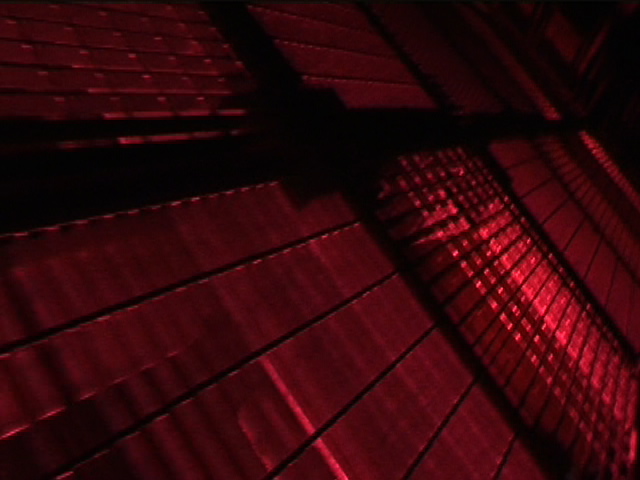
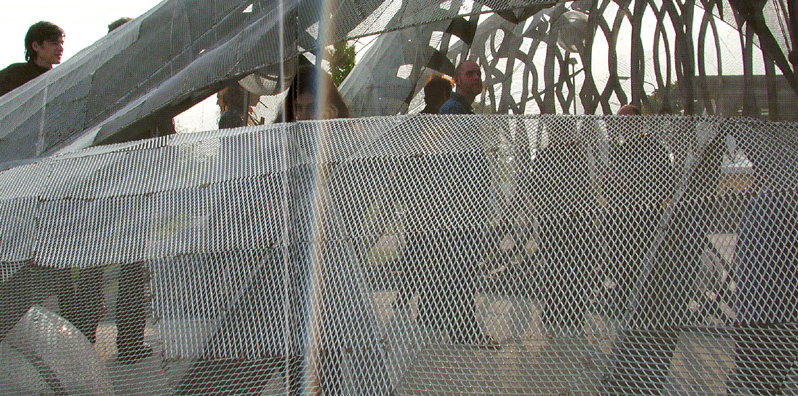 Son-O-House,
with visitors
Son-O-House,
with visitors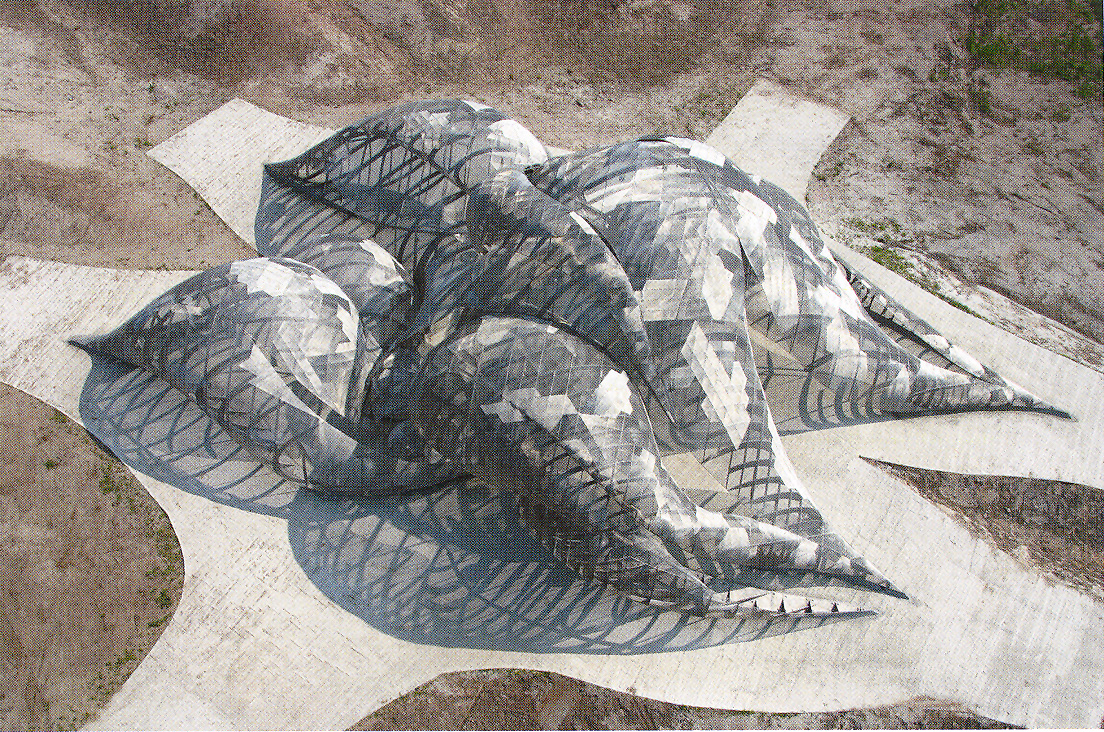
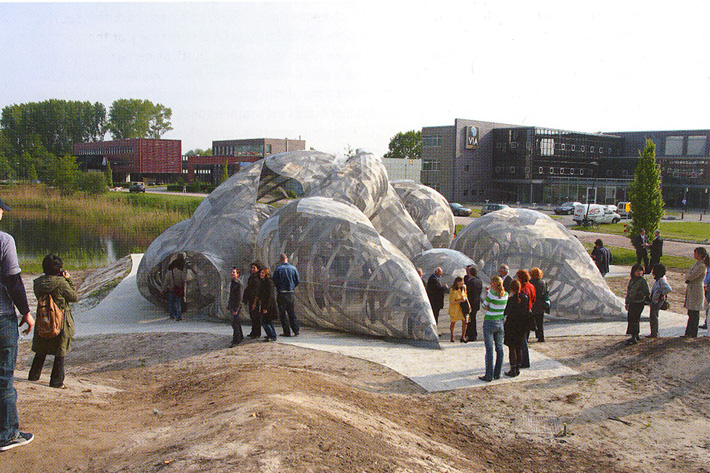 opening of Son-O-House, May 2004
opening of Son-O-House, May 2004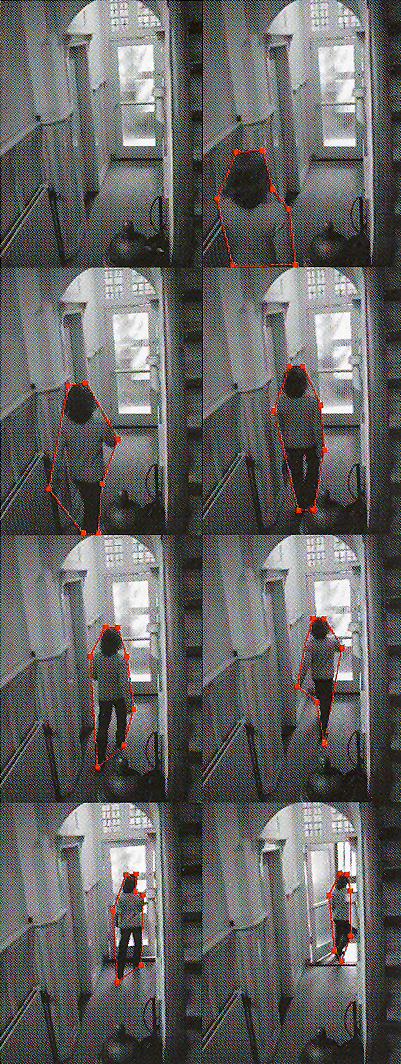 .
. 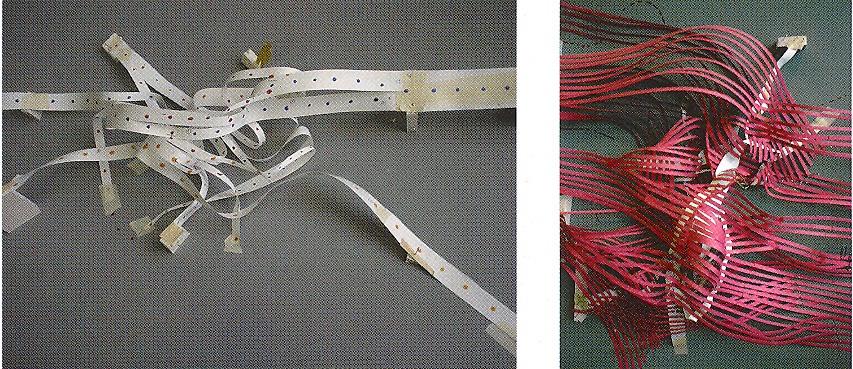 paper
strips, connective trissues, 3D porous structure
paper
strips, connective trissues, 3D porous structure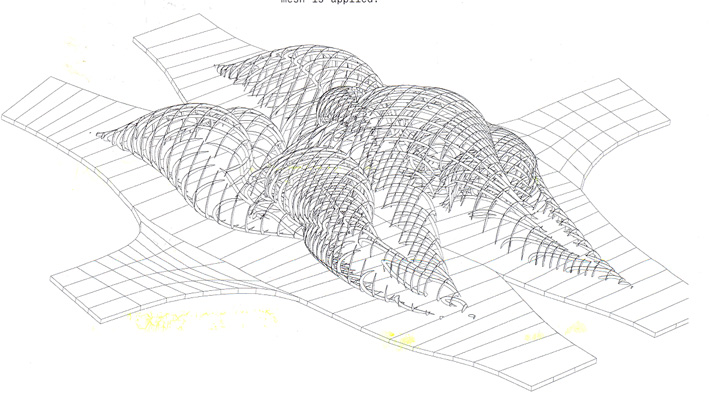 .
.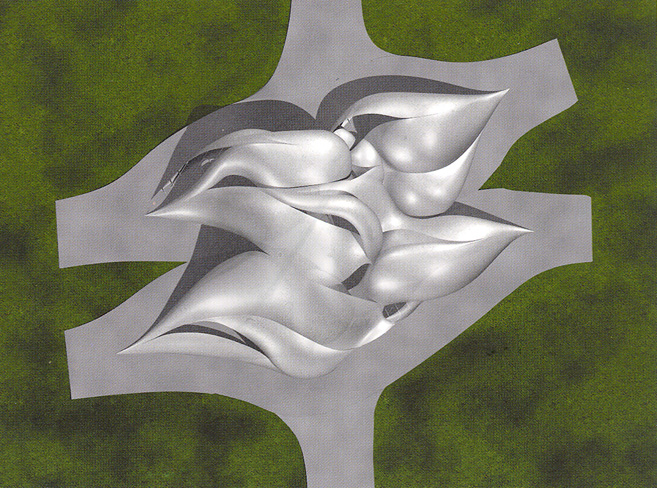 . digitization
of paper model
. digitization
of paper model